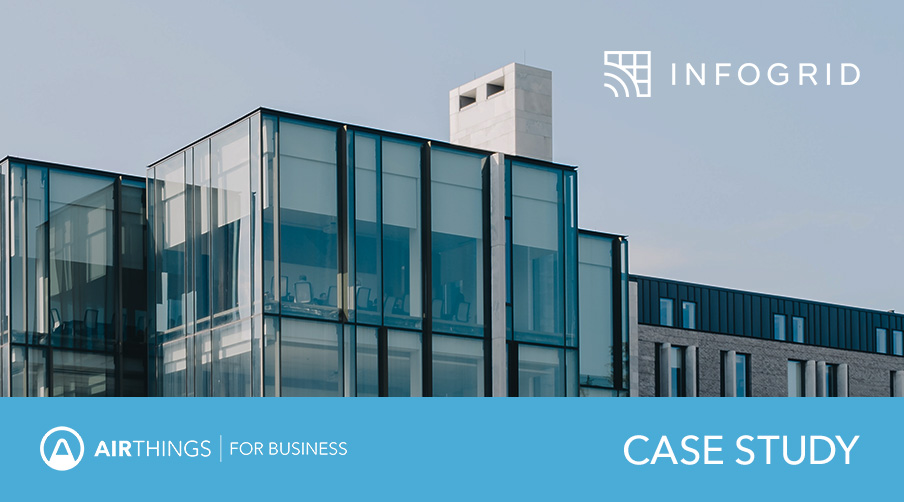
Find out how Airthings air quality data helped set Infogrid apart from their competition in our latest case study. With the best air quality technology money can buy, you can improve the health and wellbeing of occupants and boost energy efficiency for all of your clients. But you don’t have to take our word for it, here’s what Infogrid has to say:
“Airthings has enabled us to provide a world-class indoor air quality solution that effortlessly integrates with our Healthy Buildings solution. It allows us to provide an easy-to-install, scalable and affordable solution that improves the air quality around us, leading to better workplaces and more energy efficient buildings.“
- Ruth Norman, Infogrid
Infogrid’s smart building platform combines many IoT sensors with powerful AI to automate and optimize facilities and building management. Their end-to-end system enables Facilities Managers and Estate Owners to create efficient, healthy, and sustainable buildings while strengthening compliance and reducing costs.
By bringing air quality into the mix, Infogrid can identify issues as soon as they arise, providing a level of insight that puts them ahead of the competition. Thanks to Airthings’ open API, Infogrid can integrate their clients’ air quality data via their Web App, alongside multiple sensors, providing a wide range of use cases that can be used by their end clients. 
Infogrid wanted to provide solutions for both Facilities Managers and tenants to deliver a healthy building for all. The challenge? Although the two parties work closely together they don’t usually possess or share data on air quality. In order to combine the FM's motivation to drive down energy costs and the tenant's desire to improve the workplace for a healthier workforce, sharing IAQ data was essential.
Airthings is part of Infogrid’s product offering to clients. With seamless integration via our open API, the air quality data provides the health and wellbeing data that’s needed to set them apart from the rest. Infogrid can tailor their solution to meet the exact needs of their clients and make life easy for Facility Managers everywhere. The three main aspects to consider, depending on deployment and usage are:
With indoor air quality data, the health, wellbeing, and productivity of your workforce can be prioritized. Carbon dioxide (CO2) monitoring is of the utmost importance to ensure “brain fog” is avoided in overpopulated meeting rooms with high levels of CO2, affecting productivity and clarity in decision making. A spike in CO2 levels can also indicate a lack of airflow, which is especially important in the post-COVID workplace.
As we know, personal comfort for those in a building may differ from person to person. By measuring indoor air quality, Infogrid’s clients could justify work orders and manage concerns more effectively and efficiently. Too warm in one area but cold in the other? A draft could be the cause of that, or it could be personal preference. With data at your fingertips, you’ll know exactly what to do. The same goes for humidity and carbon dioxide.
Some of Infogrid’s clients may wish to become certified for BREEAM, WELL, or FitWell, etc. These particular certifications require regular monitoring of particulate matter. With Airthings for Business, you can measure particulate matter and carbon dioxide to help towards these accreditations. You can read more about Airthings for Business and RESET here→
Evidently, health and wellbeing, personal comfort, and air quality accreditations all play a role in Facilities Managements’ responsibilities. Fine-tuning the workplace’s HVAC system in order to deliver better quality air to the client is key. On top of this, you can reduce energy usage by optimizing systems and not running them unnecessarily.
Infogrid purchased their first Airthings sensors in late 2019, and had already sold their first sensors to their clients by January the following year (or 2020)!
With battery-powered sensors that can be retro-fitted effortlessly to almost any building and low ongoing maintenance, the Airthings solution really can work for you.
We asked if they were able to offer your customers the best air quality data in the market when integrating with the Airthings API. They said:
"We believe so. It’s a competitive space, but the unique combination of beautiful, wireless, long-life battery sensors that take great readings and have an easy access open-API is surprisingly rare."
Ruth Norman, Infogrid.
It is widely felt that the air quality market has grown massively in the last few years. Infogrid’s use of Airthings for Business has undoubtedly helped demonstrate how in touch they are with the ever-changing needs of the sector.
Employers are really starting to think about the environment in which their employees work, both to attract and retain the best talent and get the best performance out of them by providing a pleasant and attractive working environment. That, combined with the demand for Facility Management providers to justify their performance in reaching those goals vs outdated and inflexible BMS wired sensor solutions, has led to a huge rise in demand, only accelerated by the recent COVID-19 pandemic.